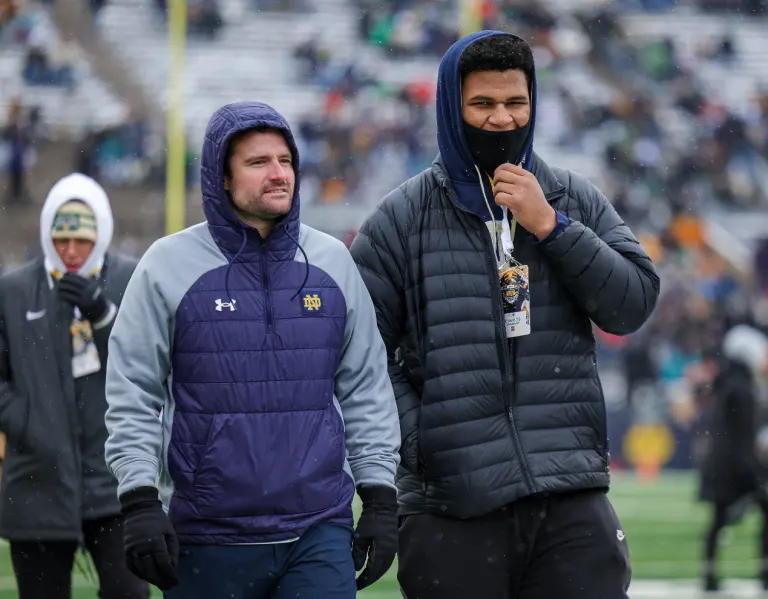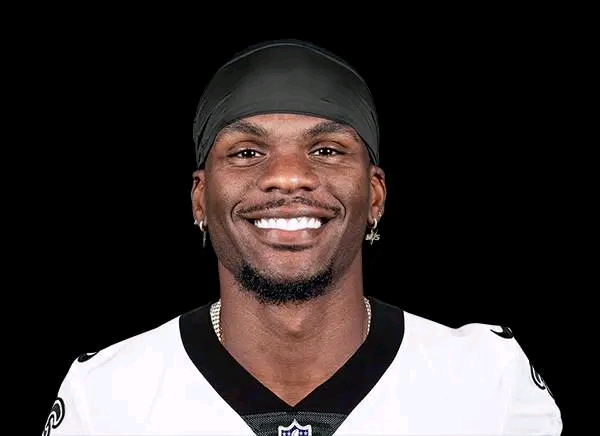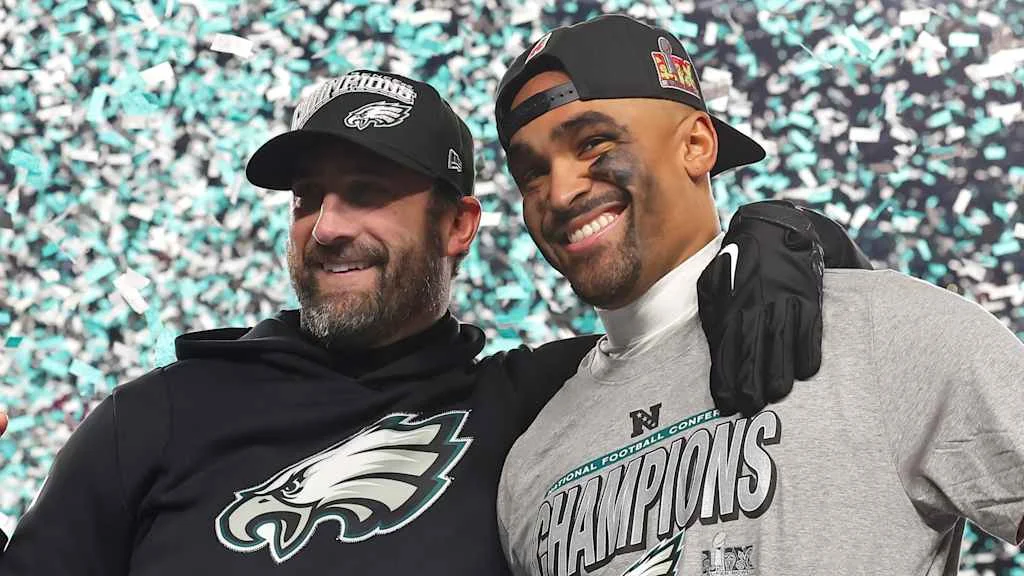Here Come The Irish” is not a hard-hitting documentary, and it doesn’t try to be. In fact, it wears its bias proudly. This behind-the-scenes look at the 2023 Notre Dame Fighting Irish football season is produced in-house, narrated by program alum and current media personality Mike Golic Jr., and offers an inside view of what it’s like to live, breathe, and believe in Notre Dame football. For many Fighting Irish fans, that’s more than enough. For outsiders, skeptics, or anyone hoping for a more journalistic take on the season, this project will come off as polished propaganda—entertaining, emotionally stirring, and absolutely lacking in critique.
But let’s not pretend this isn’t what most fans want. The docuseries format, which follows Notre Dame football from the preseason through bowl season, touches all the emotional bases: gritty off-season workouts, locker room speeches, slow-motion highlights drenched in autumn light, and tear-jerking senior night farewells. It’s built to reinforce belief in the program and its values, and while it may lean too hard on hero worship and myth-making, it never forgets its primary goal—celebrating Notre Dame and reigniting loyalty in its base.
From a production standpoint, “Here Come The Irish” is slick. Visually, it’s beautifully shot. The camera work ranges from cinematic tracking shots of campus to tight, intimate glimpses of players as they battle both opponents and inner doubt. The musical score, soaring and sentimental, underscores every moment with the appropriate weight. The editing is deliberate and rhythmically on point, and the transitions between practices, games, and personal interviews show a clear understanding of emotional pacing.
What the series does particularly well is create characters. Players like Sam Hartman, Benjamin Morrison, and Audric Estimé are presented not just as athletes, but as personalities with emotional arcs. Hartman’s arrival as a grad transfer from Wake Forest is depicted as the missing piece of a championship puzzle. His Southern charm, mature demeanor, and commanding on-field presence are played up almost to the point of sainthood. Whether he lives up to the lofty expectations set for him is up for debate, but within this series, he is the unchallenged general of a proud army.
Coach Marcus Freeman, in only his second year as head coach, is portrayed as a rising star of college football coaching—a leader of men and a spiritual heir to the Notre Dame tradition. His speeches anchor many of the episodes, and though they sometimes veer into cliché, the passion behind them is palpable. The camera loves Freeman, and the series clearly wants you to see him as the program’s guiding light for the next decade. The real-life coaching decisions, game missteps, and criticisms that dotted his 2023 campaign are conspicuously absent.
That leads to the central contradiction in “Here Come The Irish”: it’s a love letter that sometimes forgets the full story. The 2023 season had moments of greatness—dominant wins, breakout performances, and real signs of growth—but it was not a fairytale. Losses to Ohio State, Louisville, and Clemson raised real questions about the team’s ability to close big games and Freeman’s game management under pressure. But those moments are presented with soft focus, buried under layers of inspiring voiceovers and postgame platitudes. The emotional honesty of the players is real, but the context is sanitized.
For example, the crushing last-second loss to Ohio State is portrayed almost as a noble defeat, with more attention paid to the team’s effort and camaraderie than to the 10-men-on-the-field blunder that cost them the game. There’s no mention of fan outrage or media criticism. The Louisville loss is similarly glossed over, reframed as a “character-building moment” rather than a tactical misfire. While these editorial choices make for a cleaner, more uplifting narrative, they also dilute the authenticity of the story.
That said, “Here Come The Irish” does deliver genuine emotion, especially in its quieter moments. When a walk-on makes his first tackle, or when a senior reflects on his final game in Notre Dame Stadium, the series shines. These are not moments for national headlines, but they matter deeply to those within the program. The film respects that. It makes space for small triumphs and personal reflections that bring warmth and humanity to a sport often reduced to stats and scores.
The series also does a fine job highlighting the culture of Notre Dame—the rituals, the legacy, the expectations. Shots of the Golden Dome, the Grotto, and the marching band’s halftime crescendo are not filler; they’re foundational. Notre Dame, perhaps more than any other college football program, exists at the intersection of sport, faith, and tradition. This documentary leans into that identity with full force. You don’t just watch the games—you witness Mass before kickoff, family hugs in the tunnel, and the carrying of historical weight.
“Here Come The Irish” knows it is selling something, and that something is belief. Belief in the players, the coaches, the school, and above all, the Notre Dame ideal. It’s effective. Even viewers who aren’t fans of the team may find themselves moved by the sheer earnestness of it all. This isn’t irony-laden, self-aware sports media. It’s pure-hearted, full-throated celebration, with no apologies for its bias.
Of course, that same singular focus on positivity is also the project’s main weakness. By ignoring complexity, it risks coming off as a PR campaign rather than a meaningful chronicle. There’s a difference between storytelling and mythmaking, and “Here Come The Irish” often blurs the line. The lack of dissenting voices, critical moments, or deeper analysis of strategic shortcomings means the documentary can’t fully explore what made 2023 such a pivotal year.
There’s also a sense that this project, while built for fans, might be preaching to the choir. Without a broader narrative hook—like a championship run, a shocking upset, or a major scandal—the stakes remain relatively contained. It’s a tribute more than a tale, and viewers hoping for drama, unpredictability, or tough questions will be left wanting.
Still, the series has merit. In an era where college football is being reshaped by NIL deals, transfer portals, and TV rights drama, “Here Come The Irish” reminds viewers of the human side of the game. The players’ emotional vulnerability, the coaches’ investment, the fans’ unwavering passion—all of it adds up to something real.
For Notre Dame supporters, the series is a must-watch. It offers not just a recap of the 2023 season, but a reaffirmation of what it means to be part of the Notre Dame family. For others, it’s an interesting case study in how sports programs can use media to shape perception, build brand identity, and strengthen community.
Ultimately, “Here Come The Irish” succeeds on its own terms. It doesn’t pretend to be objective, and it never once steps outside its lane. This is Notre Dame as Notre Dame wants to be seen—glorious, gritty, proud, and perpetually on the cusp of greatness. Whether you buy into that vision or not, there’s no denying the skill with which it’s presented. The series may not ask hard questions, but it answers one with certainty: Notre Dame still believes. And it wants you to believe, too.




